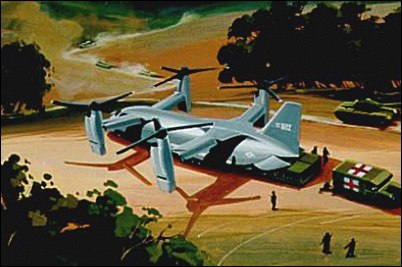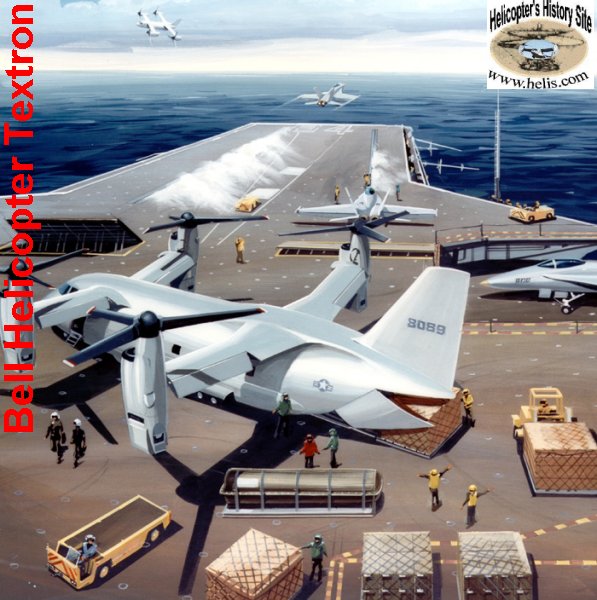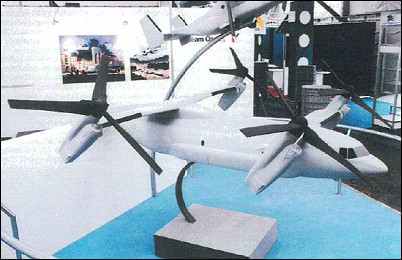Bell-Boeing Quad TiltRotor
The Bell Boeing Quad Tiltrotor ( QTR ) is a concept for a four-engine tiltrotor aircraft under the " Joint Heavy -Lift " Program of the U.S. Army. This is at least partly to a further development of the V-22 Osprey is the CH -47 and C- 130 supplement and replace in a variety of tasks. As competition pattern Karem Aircraft and Lockheed Martin to develop the optimum speed tiltrotor.
History
Background
The quad tiltrotor concept can be traced to the 1960s traced, as the first flying four-engine tilt-rotor aircraft that were XC- 142 and X -22 tested. Neither of the two prototypes ever went into production. In 1979, Bell ventured again to a four-engine tiltrotor aircraft, whereby the model D -322 failed. Until 20 years later there was another serious plans to realize such a machine. So bot 1999 Bell - Boeing the U.S. Army as part of the "Future Transport Rotorcraft " program is a four-engine V- 22. With a 50 % match components to V-22, this model should at a maximum takeoff weight of 45 tons, a payload of 11 t have. The designated Bell - Boeing V -44 design (the term has never been adopted by the U.S. armed forces ), was in its payload a few more times later reduced to achieve an even higher compliance to the V- 22. 2000 Bell tried to get into a development agreement, however, supported the U.S. Army of this approach will ultimately not.
Studies
The work on the actual QTR concept ultimately began in September 2005 when Bell - Boeing a 3.45 mil. U.S. $ development contract by the U.S. Army was to develop a concept study for a possible replacement of the CH -47 Chinnok and the C -130 Hercules. The contract had a duration of 18 months, which in March 2007 templates the results. The QTR was the contents of a total of five trials, with the remaining four were all carried out by Boeing alone and dealt with improved versions of the CH -47. The QTR Bell assumed the structure of the airfoil, the engines and the rotor. Boeing's team took care of the remaining components, including the entire internal systems ( avionics, etc.). Both teams were just like with the "V -44 " on a high component of conformity with the V- 22nd
In the summer of 2006 the first wind tunnel model of the QTR was built at a scale of 1:5 and tested in the NASA Langley Research Center. Main component of these tests was to investigate the elastic deformation of the rear rotor blades through the turbulence of the front rotor blades. In these tests, three-blade rotors were used, whereby this came from the results that you want to use four-blade rotors in further studies.
As in May 2007 templates the research results, the QTR - concept was selected for future developments; the alternative CH -47 developments were abandoned. As the vehicles of the now-defunct "Future Combat Systems " rose to a weight of 20 to 27 t, the required payload of the QTR was adjusted accordingly. In the summer of 2008, the Army continued the studies in the framework of the " Joint Heavy -Lift " program. These new contracts have been signed; received a Bell Boeing, the other went to a consortium of Karem Aircraft and Lockheed Martin, develop the design competition "Optimum Speed Tiltrotor ", which is also referred to as "Joint Heavy Lift ". The first prototypes are expected in 2012.
Construction
Structurally it is the QTR is a four -engined tiltrotor aircraft in tandem configuration. There is a 50-foot - four-blade rotor, which is driven by a propeller turbine Rolls Royce AE1107C on each wing tip. This is already in use with the V -22. The cargo hold is of its dimensions correspond to a C -130 and can carry up to 90 to 110 paratroopers. Alternatively, eight 463L pallets can be accommodated.
In the design phase currently running several configurations of Bell - Boeing examined, including a sea-based variant or an enlarged model, referred to as the "Big Boy". This would use 55 -foot rotors and have a lengthened fuselage. Thus, the payload rises to nine pallets or alternatively on a Stryker vehicle.
The different configurations are also sometimes strongly different technical data in circulation. Thus, the payload 16 to 26 T varies, the range from 420 to 1000 km. The requirements of the Army an internal payload of 15,000 kg specified, an external 20000-22000 kg. The range at maximum payload should be at 1000 km, the transfer range, however, at 4,000 km.










